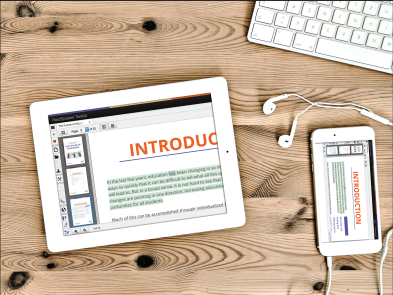
The concept of accessibility is making its way into conversations about the future of every industry, and the educational field is no exception. As schools implement more digital tools post-pandemic, many educational institutions are recognizing that they need inclusive classrooms and curriculums for online and blended learning to work. Equality of access in education is fundamental to the quality and effectiveness of students’ learning experiences.
So what is access in education and what can schools do to enhance it? We’ll explore the answers to these questions in this article.
What is access in education?
Access in education refers to the equal opportunity for people to learn, regardless of class, gender, ethnicity, or mental and physical disabilities. Universal access strives to empower all students to take full advantage of high-quality education.
While access to education is treated as a basic right in many developed countries, laws protecting educational access are primarily intended to protect primary and secondary students from discrimination. Broader universal access — which uses multimodal strategies to keep underserved students on track with their peers — still needs work.
However, the onset of the COVID-19 pandemic made equality of access in education a pressing issue. During this time, most schools and educational institutions around the world temporarily closed and transitioned to online education in an attempt to contain the virus. Distance learning left at least one-third of the world’s schoolchildren, as well as many corporate and continuing education students, without access to education at all. This demonstrated the need for more strategic accessibility and inclusion initiatives worldwide.
The Impact of COVID-19 and Online Learning on Vulnerable Students
The COVID-19 pandemic has had an impact on all students, but some individuals were affected more than others. The crisis hit the most vulnerable groups the hardest, including people with disabilities, ethnic minorities, and rural communities.
In education institutions where staff grappled with remote teaching and parents proved unprepared for homeschooling, connecting educators and students with distance learning software became the priority. The struggles of vulnerable students were often sidelined from conversations due to the urgency of the transition. However, once online learning was fully implemented, a lack of inclusion became far more evident in many areas of education.
The COVID-19 pandemic revealed the gaps in equality of access. While inequalities can be difficult to identify when evaluating individual classrooms, implementing a central learning management system (LMS) across a school makes digital inclusion issues clear. When some students are unable to complete assignments because an educational system isn’t built for them — whether they don’t have a laptop or their screen reader is incompatible with an LMS — inequalities are clearly endemic.
If the average student was 4-5 months behind in reading and mathematics after the pandemic, vulnerable students were doubly so. The pandemic and its aftereffects created many moments for institutions and students to think about the importance of equality and anti-discrimination.
In the midst of student struggles, the European Trade Union Committee for Education (ETUCE) called on local education authorities and governments to ensure the inclusion of all students and staff. Similarly, in the U.S., the Department of Education issued guidance for educators to provide equal access to information for students with disabilities and Individualized Education Plans (IEP). These calls to action served to prevent the COVID-19 situation from magnifying existing social inequalities.
The Silver Lining of the Transition to Online Learning
There are silver linings to every crisis, and the pandemic has already led to positive outcomes in education. It’s impossible to return to the past status quo, in which equal access in education was just a passing thought. As distance learning takes on a growing role in education, access to content, web accessibility, and individual learning will become even more important issues.
As Massachusetts’ former secretary of education, Paul Reville, stated in the Harvard Gazette, “There are things we can learn in the messiness of adapting through this crisis, which has revealed profound disparities in children’s access to support and opportunities. We should be asking: How do we make our school, education, and child-development systems more individually responsive to the needs of our students? Let’s take this opportunity to end the ‘one size fits all’ factory model of education.”
The current conversation about equality of access in education makes it clear that accessibility benefits more than just people with learning disabilities. During the pandemic, even students who aren’t categorized as learners in need of special education services still required additional support. This knowledge moves us closer to Universal Design for Learning, which uses more adaptable course materials to help all students maintain their educational level and succeed.
Edtech as a Basis for Equality of Access in Education
As the online nature of remote learning brings the question of web accessibility to the forefront, it has highlighted the availability of many online tools that make content more accessible. Most educational institutions relied on technology during the pandemic to give learners direct access to course materials and promote their understanding of the content at the same time.
Education technology has become an anchor for institutions. Resources like Khan Academy, Google Classroom, Duolingo, and a myriad of other distance learning solutions made it possible for educators to provide quality content and instruction to their diverse student populations.
Even while dealing with a number of pandemic-related challenges — such as IT issues, falling revenues, and parents who aren’t tech savvy — edtech helped learning institutions support universal access to education.
As learning institutions continue to implement more edtech and assistive technology, more students — including those with learning difficulties, dyslexia, and literacy needs, as well as those who are learning in a second language — will be able to fully understand content.
Educational technology also takes the issue of accessibility off of teachers’ plates and gives educators additional support. In the past, teachers were tasked with bearing the burden of transforming teaching materials and course designs for their individual classrooms and students. However, the availability of edtech allows schools to bring accessibility and inclusion to the institutional level.
Educators will no longer be solely responsible for reporting student needs to administrators. LMS technology and other digital tools allow institutions to better analyze student performance at both the individual and school-wide level using accurate metrics.
How technology can support equal access: An example

Text-to-speech (TTS) is becoming one of the most important educational technology tools for institutions around the world. Implementing TTS is a fairly simple and efficient way for institutions to provide universal access to content while simultaneously addressing requirements established by global Web Content Accessibility Guidelines (WCAG).
Text-to-speech tools read text out loud to make it easier for diverse students to process learning materials. Many of these tools, like ReadSpeaker, also highlight text as it’s read out loud and come with other speech-enabled tools — such as dictionary, dictation, pronunciation guides, page mask, enlarged text, and dyslexia guides — to help a wide variety of students access and engage with educational content.
Traditionally used as an assistive technology tool for those with learning disabilities, dyslexia, and literacy challenges, text to speech is now valued as a supportive tool for students who fit many different profiles. For example, linguistic minorities, refugees, and people who simply prefer audio can benefit from text that is read out loud.
Text to speech also plays an important role in modernizing education. Voice technology is becoming ubiquitous across our society, so as people become familiar with and dependent on voice tools, TTS will become a key to helping today’s tech-savvy learners better leverage educational materials. Text to speech, in combination with other edtech, will greatly improve the learning experience for diverse students and ensure education stays relevant to this century and the current generations.
Paving the Way for Greater Equality of Access in Education
One of the core benefits of text to speech is the fact that it’s illustrative of the benefits of educational technology solutions. While tools like learning management systems can be complex — and sometimes too broad of a concept for old-school institutions to buy into — TTS illustrates the power of edtech in more concrete ways.
Just about everyone has access to voice technology right on their phones and computers, so it’s easy to grasp how it can translate into the educational environment. TTS becomes a clear solution for everyone, from people with disabilities (who need audio to easily comprehend text) to medical students (who can save time by listening to lengthy content during their busy schedules).
TTS can be any institution’s best next step toward greater equality of access in education.
Contact us for more information
Amy Foxwell is an education technology strategist with over 20 year’s deep expertise in accessibility and digital inclusion.
At ReadSpeaker, she helps schools, universities, and corporate learning teams integrate text-to-speech solutions that improve outcomes, support diverse learners, and ensure compliance with accessibility standards.
Amy’s work is driven by a belief that every learner—whether in the classroom, on campus, or in the workplace—deserves equal access to knowledge, and that thoughtful use of technology can make that possible.


